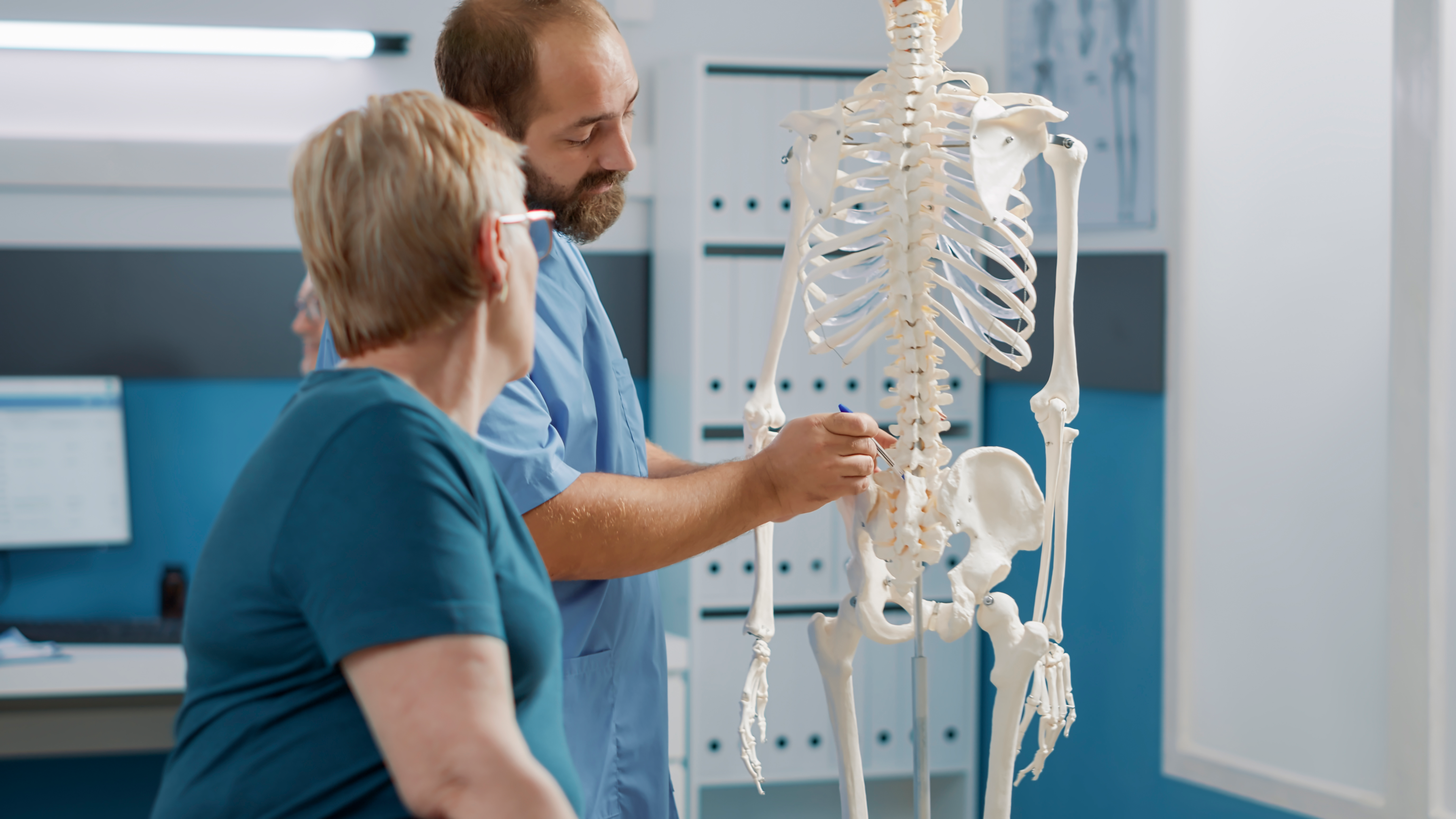Osteoporosis - Risk Factors, Symptoms and Treatment



Osteoporosis is a bone disorder that occurs when the body makes either too little bone or decreased bone density. As a result, bone density deteriorates and they are more prone to breaking from a fall or, in extreme situations, from minor bumps or even coughing.
Healthy bone appears to be a honeycomb when viewed under a microscope. The honeycomb's holes and voids are substantially greater in osteoporotic bone mass than in healthy bone. Osteoporotic bones have irregular tissue architecture and have low bone density or bulk. Less dense bones are brittle and more prone to breaking. Ask your doctor or another healthcare professional about a bone density test if you are 50 years of age or older to avoid osteoporosis-related fractures.
A major side effect of osteoporosis, particularly in older individuals, is breaking a bone. Although other bones can break, the hip fracture, spine, and wrist are the most common places for osteoporotic bone breaks. Osteoporosis results in chronic discomfort and causes some individuals to grow shorter. Osteoporosis generally causes a bent or slumped posture, affecting vertebrae or the bones in the spine.
Mobility issues brought on by osteoporosis can result in feelings of loneliness or melancholy. Additionally, complications from the broken bone itself or the operation to fix it account for 20% of senior citizens who break their hips dying within a year. Many patients need long-term care in nursing homes.
Following are the risk of osteoporosis.
Your age affects your risk of developing osteoporosis. Bone loss accelerates in women as they approach menopause. Men begin to lose more bone at 65 and older. Age links to an increase in bone fragility.
Learn more: Can menopause cause joint pain?
If your body does not get enough calcium from nutrition, it starts to remove calcium from bones to support all of its other activities. An unfavourable calcium balance could develop from this, which is bad for the health of the bones. You might want to think about taking a calcium supplement if your diet does not provide you with enough calcium.
By improving the intake of calcium, vitamin D aids in the development of stronger bones. Due to concerns with poor absorption or other risk factors/conditions linked to vitamin D insufficiency, some people may require an increased dosage than suggested.
A higher chance of getting osteoporosis is linked to a significant family history of the disease. You run an increased chance of getting osteoporosis and breaking a bone if one of your parents has had a hip fracture.
Learn more: Signs and symptoms of bone cancer.
Osteoporosis that develops secondary to another medical disease has a higher risk than primary osteoporosis. Some of them may also raise the possibility of falling and breaking bones. Examples include chronic liver disease, COPD (chronic obstructive pulmonary disease), rheumatoid arthritis, celiac disease, gastric bypass surgery, and celiac disease.
Certain drugs can accelerate bone loss and raise the risk of fracture when taken over an extended period. Some drugs raise the possibility of falls leading to a cracked sternum. Secondary osteoporosis is osteoporosis that develops as a side effect of treatment for another illness.
Certain cancer like breast cancer
Low bone mass
Weight-bearing exercises
Patients with osteoporosis experience no symptoms at the start of the disease. However, In the late stage of the disease, the patient is presented with the following symptoms.
1. Bone discomfort or soreness
2. Fractures of bone caused by minimal or no trauma.
3. Decrease in the height of bone over time, up to 6 inches.
4. Spinal bone fractures causing low back pain.
5. Fractures in the spinal bones that cause neck pain.
6. Special posture called kyphosis

Dual-energy X-ray absorptiometry is the most widely used technique to determine the bone mineral density scan (DXA). It is an easy, non-invasive, and simple check. While lying on a soft table, DXA scans your body using a low-level x-ray machine. The examination assesses the bone mineral density of your skeleton and several fracture-prone areas, including the hip and spine. The most accurate method for identifying osteoporosis and determining the risk of fracture is widely thought to be bone density testing by DXA at the hip and spine.
Some persons get peripheral DXAs, which assess the wrist and heel bone densities. The portability of this DXA type may make screening simpler. Doctors may be unable to use the findings to predict your future fracture risk or track how your medicine is impacting your condition.
Bone density may also be used to calculate your risk of developing osteoporosis. If your bone density is below a specific level in relation to other people in your category (age, sex, race), then you may be required to make adjustments to your lifestyle to improve your bone health.
Your doctor could occasionally advise a quantitative ultrasound (QUS) of the heel. This test assesses bone health but does not calculate BMD. A DXA test is still required to detect bone loss and osteoporosis even if the QUS reveals that you have lost bone tissue.
Osteoporosis treatment aims to reduce or stop bone loss and avoid fractures. Your healthcare professional might advise:
People who get osteoporosis due to another illness should consult their doctor to determine the prior illness and treat it. Certain drugs are authorised for the prevention or management of osteoporosis-related conditions caused by ageing or menopause, or if you have a long-term glucocorticoid condition.
Vitamin D and calcium are essential minerals for maintaining healthy bones and avoiding osteoporosis. Insufficient calcium intake causes the body to remove calcium from the bones, which can cause bone loss. Osteoporosis may result from this since it can thin and weaken bones. Therefore you should talk to your doctor so that they can advise a healthy diet for treating osteoporosis.
Calcium absorption from the intestines depends on vitamin D. After being exposed to sunlight; it is produced in the skin. Several foods, notably fatty fish, fish oils, egg yolks, and liver, are naturally sufficient sources of vitamin D.
An osteoporosis care plan should include exercise. According to research, strength or resistance training is one of the finest physical activities for maintaining bone health. Because bone is living tissue, exercise can strengthen bones both in adolescence and maturity. However, exercise no longer boosts bone mass in elderly persons.
Several bisphosphonates have received approval to prevent bone loss and treat osteoporosis. This kind of medication works by reducing bone loss, reducing the risk of fractures.
This medication is approved for the treatment of osteoporosis in postmenopausal women. It is often prescribed to those who are unable to take or tolerate other medications for osteoporosis.
Osteoporosis and fracture prevention in postmenopausal women is allowed with the use of oestrogen and oestrogen and progestin combination (hormone treatment). Researchers advise women to utilise hormone therapy at the lowest dose, for the shortest period, and only if other medications are not working for them because of potential negative effects. The advantages and disadvantages of oestrogen and hormone therapy for the treatment of osteoporosis must be carefully weighed.
In postmenopausal women and men with osteoporosis who are at high risk for fracture, PTH, a kind of human parathyroid hormone, is recommended because it increases bone mass. Another name for parathyroid hormone is PTHrP, which is a prescription drug. It is frequently indicated for postmenopausal women with a history of fractures and is administered as an injectable.
Learn more about medications for osteoporosis: What is AdCal D3?
If you're experiencing pain, view our range of mild-moderate pain relief medications here.
Plus get the inside scoop on our latest content and updates in our monthly newsletter.